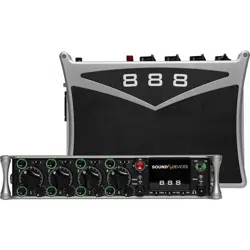Loading ...
Loading ...
Loading ...

888 User Guide
43
Mid-side linking (inputs)
When mid-side (MS) stereo inputs are used and the inputs are set to
MS linking and MS decoder is activated for those inputs. This yields
a stereo signal with one fader controlling overall input level and the
other fader controlling the “width”, or amount of the side signal
added. With an MS matrix at the input, the signal is sent to an output
bus as left/right stereo. Mixers with MS matrices often allow for
discrete mid and side signal recording. In that case the MS decoder
can be activated at the headphone selection to monitor left/right
stereo.
Mix track
A recorded track that is a sum of multiple tracks. In production sound
the mix track is often a single summed track of all production dialog
elements. Mix tracks can also be sub-mixes of like microphones, such
as a sub mix of just lavalier microphones or just boom microphones.
Monophonic WAV
A WAV le that is comprised of a single track of audio. When recording
multi-track audio with monophonic WAV les each track is recorded
to its own WAV le, with a le name indicating the track number. All
associated monophonic les that are part of a multi-track recording
will be identical lengths.
Mute
A mute control is a convenient on/off switch for a channel and an
easy way to remove a channel from appearing in downstream buses.
Mute an input or channel does not change levels or settings; when
channels are muted and unmuted, their settings remain.
Notes (metadata)
A metadata eld that is saved along with audio data in a recorded
sound le, useful for sound report generation. Some workstation
software recognizes the notes eld and presents it when viewing the
sound le.
Output
The physical connection and associated signal type sent from a
device. Outputs can be source from inputs, buses, record tracks, and
other auxiliary signals.
Output auto-mute
When set, an output signal is muted when recording is stopped,
restricting program audio from being sent to listeners “between
takes”.
Output delay
A digital delay applied at the output. Signal delay is often set at an
output to compensate for the delay introduced by digital imaging
systems so that picture and sound remain in correct “lip sync”. Output
delay is set in either frames or milliseconds.
Pan
When a channel is routed to a stereo-linked bus the level it appears at
each bus is adjusted by a pan control. A channel with its pan control
“straight up the center”, or “centered” sends signal at the same level
to each bus. A channel that is panned left or right sends the signal to
the left or right bus, respectively.
PFL, pre-fade listen
When an input or channel is selected for monitoring/solo with a PFL,
the channel is routed to the headphone output before the channel
fader so that the fader position has no effect on the headphone level.
Trim/gain changes to the input will change the headphone output.
Phantom power
Condenser (capacitor) microphones require power for operation. They
use power to charge the diaphragm backplate (for true condensers)
and power the impedance convert located adjacent to the
microphone capsule. Phantom power is the method for microphone
inputs to supply DC power to the microphone through the same
connection used for the audio signals from the microphone.
Phantom power provides a positive voltage, typically between 11-52
VDC, with 48 V being the most common, on both pin-2 and pin-3 with
pin-1 used as ground. The DC voltage appears as a common-mode
signal on the balanced connection and is rejected by the connection’s
differential amplier. Phantom power has no effect on dynamic
microphones.
Phase
The relationship one audio signal has in time with respect to another
audio signal, dened in degrees of phase. When audio signals are
generated at identical times, they are “in phase” with each other.
When one audio signal is time-delayed with respect to another the
signals are “out of phase”. Differing phase relationships can be
introduced several ways, including when microphones are placed at
varying distances from a sound source, or electrical/digital delay is
introduced to one signal with respect to another.
Phrase
A pre-set text string which can be used to quickly ll out the notes
eld.
Pre-fader routing
The signal from a channel is routed to a bus before the fader in the
signal path. The input trim, if available, controls the channel level sent
to the bus. Isolated tracks are typically recorded pre-fader so that any
level changes made to the faders don’t affect the recorded signal.
Pre-roll
A continuous buffer that is always writing to memory offering a
recording that begins prior to when the record button is activated.
Pre-roll is set in seconds, and the recording begins the set number
of seconds prior to the button being pressed. This is helpful in
applications where an operator missed a cue to begin recording.
Polarity (audio)
The direction of the current ow of an audio signal is dened as
polarity. The polarity of a signal can reversed when a balanced audio
signal connection has its pin-2 and pin-3 connections reversed.
Single-ended signals can have their polarity reversed when going
through an “inverting” gain stage. It is best practice to have all
incoming and outgoing signals with the same polarity relationship.
Polyphonic WAV
An individual WAV le that contains multiple audio tracks. When
recording multi-track audio with polyphonic WAV les all recorded
tracks are contained within a single WAV le.
Post-fader routing (after fade routing, AFL)
The signal from a channel is routed to a bus after the fader in the
signal path. The fader controls the level of the channel at the bus.
Channels sent to a master bus, such as the left/right bus, are
typically sent post-fader.
Loading ...
Loading ...
Loading ...
